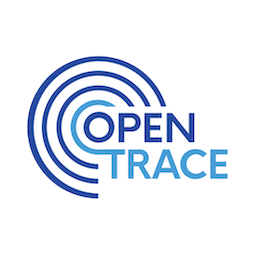OpenTrace is the open source reference implementation of BlueTrace.
BlueTrace is a privacy-preserving protocol for community-driven contact tracing across borders. It allows participating devices to log Bluetooth encounters with each other, in order to facilitate epidemiological contact tracing while protecting users’ personal data and privacy. Visit https://bluetrace.io to learn more.
The OpenTrace reference implementation comprises:
- Android app: opentrace-community/opentrace-android
- iOS app: opentrace-community/opentrace-ios
- Cloud functions: opentrace-community/opentrace-cloud-functions (this repo)
- Calibration: opentrace-community/opentrace-calibration
- Node.js v10
- Create a new Firebase Project from Firebase console.
- Enable Google Analytics for the project, to be used for Firebase Crashlytics and Firebase Remote Config.
- Make sure to upgrade the project from the "Spark" free plan to the "Blaze" pay-as-you-go plan to avoid future quota issues.
OpenTrace uses firebase auth to authenticate mobile users via OTP. An alternative approach is to setup your own OTP service to validate and store the mobile numbers in your own backend. This is not included as part of OpenTrace.
An encryption key is required to encrypt and decrypt all Temporary Identifiers (TempIDs). The recommended key's size is 256 bits (i.e., 32 bytes). It needs to be converted to Base64 for storage in GCP Secret Manager.
A simple method to generate a random key and encode it in Base64 is:
head -c32 /dev/urandom | base64It is highly recommended that the encryption key is rotated on a regular basis. This step is not included as part of OpenTrace.
Create a new secret in Secret Manager and add a new version with the key generated above. Note that this requires Billing enabled.
If you have the gcloud CLI installed you can do this in your terminal:
# You can avoid using the project flag by setting a global default project:
# gcloud config set project YOUR_PROJECT_ID
export GCLOUD_PROJECT="YOUR_PROJECT_ID"
# Create the secret
gcloud --project="${GCLOUD_PROJECT}" secrets create "EncryptionKey" --replication-policy="automatic"
# Create a "version" which contains the actual contents
echo -n "YOUR SECRET RANDOM KEY" | \
gcloud --project="${GCLOUD_PROJECT}" secrets versions add "EncryptionKey" --data-file=-The default cloud function IAM user is <project-id>@appspot.gserviceaccount.com, it needs to be given the Secret Manager Secret Accessor role in order to read data from Secret Manager.
This can be done at IAM Admin page.
Note: Depending on your Firebase configuration, the role may need to be delegated to the firebase-adminsdk-<random5chars>@<project-id>.iam.gserviceaccount.com user instead.
If you have the gcloud CLI installed you can do this in your terminal:
# Assumes you have GCLOUD_PROJECT set from the previous step
gcloud projects add-iam-policy-binding "${GCLOUD_PROJECT}" \
--member "serviceAccount:${GCLOUD_PROJECT}@appspot.gserviceaccount.com" \
--role roles/secretmanager.secretAccessorInstall the Firebase CLI via npm:
npm install -g firebase-tools@latestLog in to the Firebase CLI:
firebase loginNote: Do not use firebase init as it may overwrite some of the existing files.
Run the following command to interactively select your project and select an alias:
firebase use --addThis will prompt you to choose your Firebase project, you can choose any alias you want such as dev, stg, prd, etc:
$ firebase use --add
? Which project do you want to add? <YOUR_PROJECT_ID>
? What alias do you want to use for this project? (e.g. staging) <YOUR_SHORT_NAME>This will create the file .firebaserc at the root directory which will look like this:
{
"projects": {
"<YOUR_SHORT_NAME>": "<YOUR_PROJECT_ID>"
}
}Run the following to set the working project:
firebase use <YOUR_SHORT_NAME>Verify that the correct project is selected:
firebase projects:listIn the Firebase console navigate to the Storage tab and create two new buckets. To add a new bucket click on the three-dot "overflow" menu in the Storage browser and then click Add Bucket.
Note: If you have not already used Storage in this project you will be prompted to set up the "default" bucket first.
- upload bucket: allow Android/iOS apps to upload files here, block read access using the rule below.
rules_version = '2';
service firebase.storage {
match /b/{bucket}/o {
match /{allPaths=**} {
allow create: if request.auth != null; // Only allow write, Cloud Functions have read/write access by default.
}
}
}
- archive bucket: store processed uploaded files, block read/write access from all users using the rule below.
rules_version = '2';
service firebase.storage {
match /b/{bucket}/o {
match /{allPaths=**} {
allow read, write: if false; // Disable access to all users, Cloud Functions have read/write access by default.
}
}
}
If you have the firebase CLI installed you can deploy these rules from your terminal:
# See firebase.json for the mapping between target names and rules files
firebase target:apply storage upload "YOUR_UPLOAD_BUCKET_NAME"
firebase target:apply storage archive "YOUR_ARCHIVE_BUCKET_NAME"
firebase deploy --only storageRun the following to install dependencies:
npm --prefix functions installCopy functions/src/config.example.ts to functions/src/config.ts and update all values accordingly. The most important configs are:
-
projectId: Project ID -
regions: All regions to deploy the functions to, possible values can be found in:functions/src/opentrace/types/FunctionConfig.tsor at Google's Cloud locations page. -
encryption.defaultAlgorithm: The default cipher algorithm used for encrypting TempIDs, e.g.,aes-256-gcm,aes-256-cbc. The full list can be found on Mac/Linux by runningopenssl enc -ciphers. -
encryption.keyPath: The name of the secret created in Encryption Key section. -
upload.bucketandupload.bucketForArchive: The names of the buckets set up in Firebase Storage Buckets section.
The class PinGenerator uses a plain substring to generate a pin from user uid. It should be subclassed with a secure implementation.
-
To prepare for the test, create a new service account key from the Firebase Service account. Refer to https://cloud.google.com/iam/docs/creating-managing-service-account-keys
-
Download the json credential file and set the path to
GOOGLE_APPLICATION_CREDENTIALSenvironment variable. More info: https://cloud.google.com/docs/authentication/production
export GOOGLE_APPLICATION_CREDENTIALS="path/to/your/service-account.json"- Once setup, run the test with:
npm --prefix functions testRun the following to deploy the functions:
firebase deploy --only functionsOnce deployed, view the Functions in Firebase console or at GCP Cloud Functions.
If you have set up either the Android app or iOS app, you can test the functions by opening the app, going through the registration and verifying that the app displays a pin code in the Upload page.
1.0.1
- Added alternative for Firebase Authentication
- Recommend key rotation
1.0.0
- Initial Release
